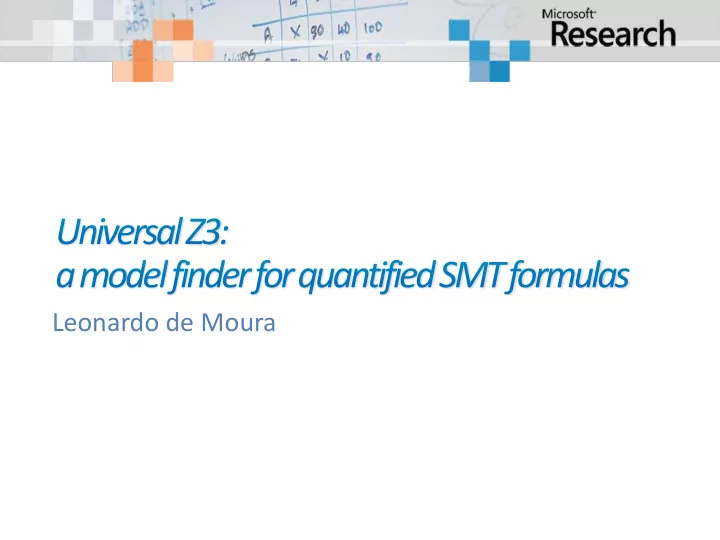

Leonardo de Moura
Quantified SMT formulas. Applications: synthesis, software verification, ... forall x. f(x, x) >= x+a, f(a, b) < a, a > 0 Models as functional programs. f (x1, x2) = if (x1 = 1 and x2 = 2) then 0 else x1 + 1 Online demo at the Z3 website.
Leonardo de Moura and Grant Passmore
Satisfiable F (model) Theorem Prover/ Satisfiability Checker Unsatisfiable Config (proof) Z3 has more than 300 options
Current SMT solvers provide a combination of different engines
DPLL Congruence Simplex Closure Grobner Simplification SMT Basis … - elimination KB Completion Superposition
Actual feedback provided by Z3 users: “Could you send me your CNF converter?” “I want to implement my own search strategy.” “I want to include these rewriting rules in Z3.” “I want to apply a substitution to term t .” “I want to compute the set of implied equalities.”
Popularized by SMT solvers such as: Simplify. Part of SMT-LIB 2.0 standard. push, assert(F1), push, assert(F2), check, pop, assert(F3), check Is Is F1 and F2 F1 and F3 Sat? Sat?
Popularized by SMT solvers such as: Simplify. Part of SMT-LIB 2.0 standard. push, assert(F1), push, assert(F2), check, pop, assert(F3), check Users need more than that! Is Is F1 and F2 F1 and F3 Sat? Sat?
Different Strategies for Different Domains.
Different Strategies for Different Domains. From timeout to 0.05 secs …
Join work with C. Wintersteiger and Y. Hamadi FMCAD 2010 QBVF = Quantifiers + Bit-vectors + uninterpreted functions Hardware Fixpoint Checks. Given: and Ranking function synthesis.
Z3 is using different engines: rewriting, simplification, model checking, SAT, … Z3 is using a customized strategy . We could do it because we have access to the source code.
SMT solvers are collections of little engines. They should provide access to these engines. Users should be able to define their own strategies.
Inspired by ideas from: Interactive Theorem Proving: Tactics, Goals, … Rushby’s Tool Bus.
Simplifier Rewriter CNF, NNF, SKNF converters Procedures for: Quantifier Elimination Gaussian Elimination Grobner Basis Polynomial Factorization ….
Goal = set of formulas. … … A tactic splits a goal in sub-goals. It also provides a model-builder and a proof-builder.
A tactic splits a goal in a “stream” of sub -goals. The “stream” may be produced on -demand. It is easy to support over/under approximations.
In most cases it is not feasible to manually inspect the state of a goal. Probes provide statistics or abstract views of goals.
Or tactics that receive other tactics as arguments. It opens so many possibilities. Example: Abstract Partial CAD in RAHD More about that in Paul Jackson’s talk.
It is based on the “Boolean - Abstraction” Tactic. AKA (Lazy DNF converter) (a < 2 a > 3) (not (a < 2)) b = a (b < 2 b > 4) p roduces the “stream”: a > 3 (not (a < 2)) b = a b < 2 a > 3 (not (a < 2)) b = a b > 4
A common idiom in SMT is: Perform “cheap” theory reasoning during the search. Perform “expensive” theory reasoning after a full Boolean assignment is produced. These should be parameters to a more general strategy.
Communication based on SMT-LIB 2.0 format. + extensions Basic capability: “naming” of formulas, goals, tactics, ... (any entity) Working in progress: Z3 ↔ RAHD demo.
Different domains need different strategies. We must expose the little engines in SMT solvers. Interaction between different engines is a must. Users can try their little engines in the context of a much bigger infrastructure. More transparency.
Recommend
More recommend